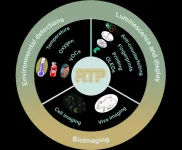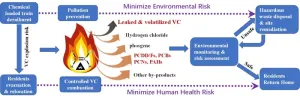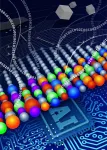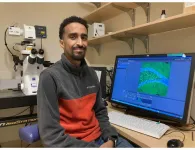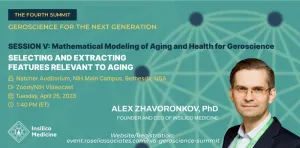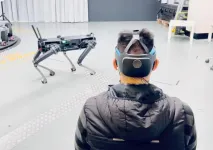Anticancer drugs with fewer side-effects: scientists decode the crystal structure of a key cell cycle protein
Scientists from Japan reveal the crystal structure of a cell cycle motor protein, which could be a potential anticancer drug candidate
2023-04-03
(Press-News.org)
Anticancer drugs are pivotal to cancer treatment, but their toxicity may not always be limited to cancer cells, resulting in harmful side-effects. To develop anticancer therapies that have fewer adverse effects on patients, scientists are now focusing on molecules that are less toxic to cells. One such group of drugs is the "kinesin inhibitors." These inhibitors prevent cancer progression by explicitly targeting kinesin motor proteins, which are required for the division of cancer cells. Centromere-associated protein E (CENP-E), a member of the kinesin motor protein, is a promising target for inhibitor therapy, as it is essential for tumor cell replication. However, determining the structure of CENP-E is crucial to identify inhibitor molecules that can bind to CENP-E and arrest the function.
Interestingly, the binding of the energy molecule—adenosine triphosphate (ATP)—to the motor domain of CENP-E changes its structure or configuration. This also occurs when CENP-E binds to an inhibitor. So far, very few CENP-E inhibitors have been reported and none have been approved for clinical use. It is, therefore, important to acquire structural information on the CENP-E motor domain.
To this end, a research team from Tokyo University of Science (TUS) in Japan used X-ray crystallography to elucidate the crystal structure of the complex formed by the CENP-E motor domain and a kinesin inhibitor.
The study, which was led by Professor Hideshi Yokoyama from TUS, along with co-authors Ms. Asuka Shibuya from TUS, and Assistant Professor Naohisa Ogo, Associate Professor Jun-ichi Sawada, and Professor Akira Asai from the University of Shizuoka, was published in FEBS Letters on February 23, 2023. “CENP-E selectively acts on dividing cells, making it a potential new target for anticancer drugs with fewer side-effects”, says Dr. Yokoyama while discussing the motivation underlying this study.
First, the team expressed the CENP-E motor domain in bacterial cells, following which they purified and mixed it with adenylyl-imidodiphosphate (AMPPNP)—a non-hydrolyzable ATP analogue. The mix was crystallized to obtain exhaustive X-ray data. Using this data, the team obtained the structure of CENP-E motor domain-AMPPNP complex. Next, they compared the structure with that of CENP-E-bound adenosine diphosphate (CENP-E-MgADP) as well as with other previously known kinesin motor protein-AMPPNP complexes. From these comparisons, the team speculated that the helix alpha 4 in the motor domain was likely to be responsible for the loose binding of CENP-E to microtubules, i.e., cell structures that are crucial to cell division.
“Compared to the α4 helices of other kinesins, the α4 of CENP-E binds slowly and with lesser strength to microtubules as compared to other kinesins, throughout the ATP hydrolysis cycle”, adds Dr. Yokoyama.
The discovery of the crystal structure of the complex is expected to facilitate additional structure-activity relationship studies, which will bring scientists a step closer to developing anticancer drugs targeting CENP-E. The research team is optimistic about the future applications of their research and are confident that it will be possible to design drugs based on the methods employed in this study. “The ultimate goal is to use the preparation and crystallization methods described in our study for future drug design studies that aim at developing anticancer drugs with fewer side-effects,” concludes a hopeful Dr. Yokoyama.
We, too, believe that this study will bring cancer patients new hope and alleviate the side-effects they experience during treatment.
***
Reference
DOI: https://doi.org/10.1002/1873-3468.14602
About The Tokyo University of Science
Tokyo University of Science (TUS) is a well-known and respected university, and the largest science-specialized private research university in Japan, with four campuses in central Tokyo and its suburbs and in Hokkaido. Established in 1881, the university has continually contributed to Japan's development in science through inculcating the love for science in researchers, technicians, and educators.
With a mission of “Creating science and technology for the harmonious development of nature, human beings, and society", TUS has undertaken a wide range of research from basic to applied science. TUS has embraced a multidisciplinary approach to research and undertaken intensive study in some of today's most vital fields. TUS is a meritocracy where the best in science is recognized and nurtured. It is the only private university in Japan that has produced a Nobel Prize winner and the only private university in Asia to produce Nobel Prize winners within the natural sciences field.
Website: https://www.tus.ac.jp/en/mediarelations/
About Professor Hideshi Yokoyama from Tokyo University of Science
Dr. Hideshi Yokoyama is a Professor at Tokyo University of Science’s Faculty of Pharmaceutical Sciences. He has 23 years of research experience and has contributed to more than 47 scientific articles in reputed journals. His primary research focus is the structural biology of membrane signaling proteins or drug-target proteins using X-ray crystallography. Prof. Yokoyama has also received the Award for Young Scientists in Tokai Branch of Pharmaceutical Society of Japan. He is a visiting professor at Université Paris-Sud in France and has previously worked at the University of Shizuoka, Japan’s National Institute of Advanced Industrial Science and Technology, and the Japan Society for the Promotion of Science.
Funding information
This study was financially supported by the Japan Society for the Promotion of Science. Grant Numbers: 17K07316, 22K06554.
END
[Attachments] See images for this press release:
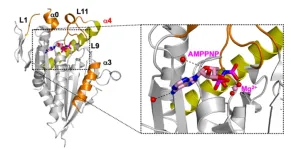
ELSE PRESS RELEASES FROM THIS DATE:
2023-04-03
Organic materials with room-temperature phosphorescence (RTP) emission have attracted extensive attention due to extraordinary properties including long lifetime, large Stokes shift, stimuli-responsiveness, and so on, and show bright prospects in broad fields. However, the energy of the excited state of organic phosphors is easily consumed through thermal radiation and collision deactivation. Therefore, numerous design strategies such as creating a rigid environment through crystallization and supramolecular assembly are employed to improve the luminescent characteristics of RTP materials by restricting nonradiative transition, enhancing intersystem crossing, and so forth. A team ...
2023-04-03
ROCKVILLE, Md. (April 3, 2023)— Today the American Kidney Fund (AKF) announced the recipients of this year’s Clinical Scientist in Nephrology (CSN) fellowship program, in which promising researchers work to improve the quality of care for people living with kidney disease and promote clinical research in nephrology. Dr. Alexandra Bicki, a pediatric nephrology fellow at the University of California, San Francisco, will be working on identifying facilitators and barriers to home dialysis and living kidney donor transplantation among adolescents and young adults, while Dr. Nivetha Subramanian, a nephrology fellow at ...
2023-04-03
SAN ANTONIO – April 3, 2023 — Southwest Research Institute has installed a large-capacity liquid hydrogen tank to expand its advanced hydrogen energy research initiatives. Leveraging the tank’s capabilities alongside a multidisciplinary research approach, SwRI endeavors to explore technology opportunities and address obstacles related to hydrogen energy research and development.
The SwRI liquid hydrogen storage tank has a capacity of 17,000 gallons and will provide the Institute with a cost-effective, reliable supply of hydrogen ...
2023-04-03
On February 3, 2023, a train derailed in the United States near East Palestine, Ohio, leading to the combustion of vinyl chloride. Following that accident, an international team of researchers undertook an in-depth analysis of the environmental consequences of the accident.
Their analysis is published in the journal Frontiers of Environmental Science & Engineering on March 15, 2023.
In their analysis, the team examined a series of questions related to the environmental risk and management of the chemical accident. “We emphasized that it is unscientific to overestimate or underestimate the environmental ...
2023-04-03
Advanced materials are urgently needed for everyday life, be it in high technology, mobility, infrastructure, green energy or medicine. However, traditional ways of discovering and exploring new materials encounter limits due to the complexity of chemical compositions, structures and targeted properties. Moreover, new materials should not only enable novel applications, but also include sustainable ways of producing, using and recycling them. Researchers from the Max-Planck-Institut für Eisenforschung (MPIE) review the status of physics-based modelling ...
2023-04-03
New research at the University of Massachusetts Amherst zeroes in on the root cause of adverse health effects from disruption of the body’s circadian rhythms, which typically occurs from jet lag and rotating work shifts.
The research, published in the journal eNeuro, also shows that the circadian clock gene Cryptochrome 1 (Cry 1) regulates adult neurogenesis – the ongoing formation of neurons in the brain’s hippocampus. Adult neurogenesis supports learning and memory, and its disruption has been linked to dementia and mental illness.
“Circadian disruption impacts a lot of things,” says lead author Michael Seifu Bahiru, a Ph.D. candidate in the ...
2023-04-03
Insilico Medicine founder and CEO Alex Zhavoronkov, PhD, a pioneer in generative AI for drug discovery and in uncovering dual pathways for aging and disease, will present at The Fourth Summit: Geroscience for the Next Generation organized by the Geroscience Interest Group of the National Institutes of Health (NIH) and the U.S. Department of Health and Human Services, happening April 24-26 at the NIH Main Campus in Bethesda, Maryland. Zhavoronkov will speak April 25, 1:40pm ET as part of the session on Mathematical Modeling of Aging and Health for Geroscience on “Selecting and Extracting Features Relevant to ...
2023-04-03
It sounds like something from science fiction: Don a specialized, electronic headband and control a robot using your mind. But now, recent research published in ACS Applied Nano Materials has taken a step toward making this a reality. By designing a special, 3D-patterned structure that doesn’t rely on sticky conductive gels, the team has created “dry” sensors that can measure the brain’s electrical activity, even amidst hair and the bumps and curves of the head.
Physicians monitor electrical signals ...
2023-04-03
Older adults perceive artificial intelligence as more human-like than younger adults do
Toronto, April 3, 2023 – Artificial intelligence (AI) is increasingly present in all of our lives, from newer offerings like ChatGPT to more established voice systems such as automated phone services, self-checkouts, Apple’s Siri and Amazon’s Alexa. While these technologies largely benefit us, they can also be used in adverse ways – for instance, in fraudulent or scam calls – making it important for us to be able to identify them.
According to a recent Baycrest study, older adults appear to be less able to distinguish ...
2023-04-03
SPOKANE, Wash. – An online “e-health” program helped more people with chronic pain reduce their opioid medications and pain intensity than a control group that had only regular treatment in a recent clinical study.
In the study published in the journal Pain, about 400 participants who had been prescribed long-term opioid treatment for their pain were divided into two groups: one received treatment as usual and another received treatment and access to a self-guided, e-health program. Of the e-health group, more than half, 53.6%, were able to reduce their ...
LAST 30 PRESS RELEASES:
[Press-News.org] Anticancer drugs with fewer side-effects: scientists decode the crystal structure of a key cell cycle protein
Scientists from Japan reveal the crystal structure of a cell cycle motor protein, which could be a potential anticancer drug candidate

